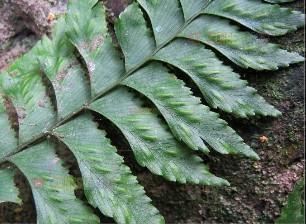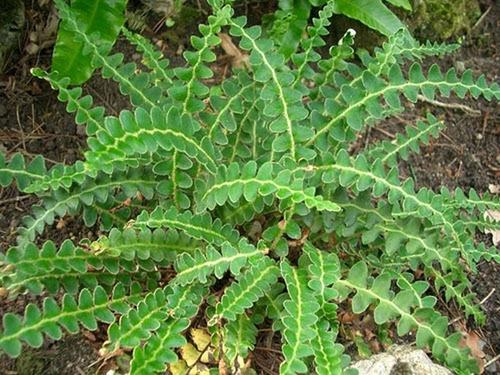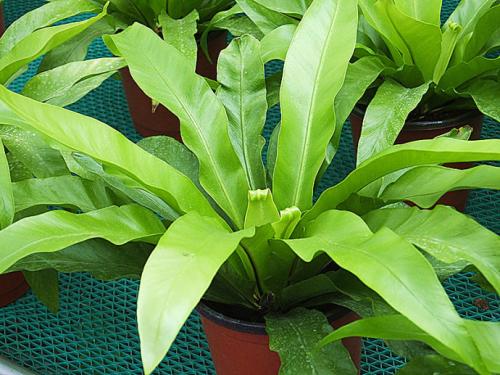Asplenium trichomanes (maidenhair spleenwort) profile
Written by Maggie
Mar 26 2021

Asplenium Trichomanes (maidenhair spleenwort) is a perennial herbaceous. Leaves are tufted; Petiole is 3 ~ 10 cm long, brown or dark brown shiny; Leaves are pinnate, linear-lanceolate, 10 -- 25 cm long, 1.2 -- 1.5 cm wide, slightly tapering at both ends; Pinnae are sparsely grown, about 20 pairs, with a very short stalk, observant or fan-elliptic, 5 ~ 6 mm long, apex obtuse, anterior margin serrate, base broadly cuneate; Leaves are slightly herbaceous, surface dense green. The sporangium is linear, 6 to 8 on each pinnacle, slightly oblique to the midvein, cyst cover homomorphic.
Asplenium Trichomanes picture

Asplenium Trichomanes info
| Botanical Name | Asplenium trichomanes |
| Common Names | maidenhair spleenwort |
| Plant Type | Fern |
| Sun | Full Sun, Partial Shade |
| Hardiness Zones | 5 to 8 |
| Flower color | Non-flowering |
| Native Area | Northern temperate areas, tropical mountains |
| Mature size | 0.33 to 0.66 feet tall, 0.75 to 1.00 feet wide |
Morphological Characteristics of Asplenium Trichomanes
Plants of Asplenium Trichomanes are 10-30 cm tall. The rhizome is short and erect, ca. 2 mm thick, densely scaly; Scales are linear-lanceolate, 3-4 mm long, ca. 0.5 mm wide at the base, thickly membranous, black, shiny, iridescent, entire.
Leaves of Asplenium Trichomanes are numerous, densely fascicled; Petiole is 2 -- 8 cm long, ca. 1 mm thick, chestnut brown, glossy, base densely covered with the same scales as on the rhizome, smooth upward, with a broad longitudinal groove above, with brown membranous entire narrow wings on either side, rounded, brittle below, leaf blade often abscissed and stalk persistent; Leaf blade is linear, 10 -- 25 cm long, 9 -- 16 mm wide at center, long acuminate, base slightly narrowed, pinnate; Pinnae ca. is 20-30 pairs, opposite at base, opposite or alternate upward, spreading, subsessile, middle pinnae of equal size, 3.5 -- 6 (-9) mm long, 2 -- 4 (-5) mm wide, elliptic or ovate, rounded head, obtuse teeth.
The base of Asplenium Trichomanes is nearly symmetrical or asymmetrical circular wedge-shaped, the upper side is larger, occasionally or with a small auricular protuberant, the whole margin, on both sides of the edge of the small round teeth; The central pairs of pinnae are 4 -- 8 mm apart, separated from each other, and the lower ones are gradually moving away and shrinking downward. They are variously oval, round, fan-shaped, triangular or pear-shaped. Veins of Asplenium Trichomanes are pinnate, slender, both sides are not obvious, small veins extremely oblique upward, binomial, occasionally single, the pinnate base of the upper side of a vein often two back binomial, not up to the edge of the leaf. Leaves are papery, grassy green, brownish-green or brown after drying; Axis chestnut is brown, shiny, smooth, with a broad longitudinal groove above, on both sides of the brown membranous whole narrow wing, round below.
Sporangium of Asplenium Trichomanes is broadly linear, 1-3.5 mm long, yellowish-brown, extremely oblique upward, usually on upper lateral veins, 4-8 per pinnacle, between the main vein and the leaf margin, not reaching the leaf margin; Capsules are broadly linear, grayish-white, later brownish, membranous, entire, open to main veins, persistent.
Ecological habits of Asplenium Trichomanes
Asplenium Trichomanes are fond of warm and humid environments. They are often born under the forest, at the edge of the forest and on the rocks and walls of the valleys, with an altitude of 400-3400m. Asplenium Trichomanes are widely distributed in temperate, subtropical and tropical mountains. Asplenium Trichomanes are suitable for under forest cultivation in limestone soil areas. Potted plants are good shade-tolerant foliage plants, but also like sunshine.

The distribution area of Asplenium Trichomanes
Asplenium Trichomanes are widely distributed in Shanxi, Shaanxi, Gansu, Xinjiang, Jiangsu, Anhui, Zhejiang, Jiangxi, Fujian, Taiwan, Henan, Hubei, Hunan, Guangdong, Guangxi, Sichuan, Guizhou, Yunnan and Xizang. Living at an altitude of 400~3400m in the valley under the forest on the rock or stone crevices, like wet and cloudy environment, more frost resistance. They are often found in cracks in the rocks or in hard, solid soil. Asplenium Trichomanes are widely distributed in temperate regions and tropical, subtropical mountains all over the world.Origin of type specimen: Europe.
Cultivation of Asplenium trichomanes
Choose the soil
Choose concealed, moist forest or forest edge ground cultivation, soil with fertile loose, deep calcareous loam had better. After selecting the land, remove weeds, shrubs and thorns, turn it over 20cm deep, and rake it fine and level it, so that the soil is loose and flat with air permeability and water permeability. Scattered humus soil and the appropriate amount of calcium magnesium phosphate fertilizer per mu, as a 1.3-1.5 meters wide bed.
Field management
During the growth of Asplenium trichomanes, water should be used frequently to keep the soil moist and ensure high air humidity in the field microclimate. Often plow weeding, make the ground loose, not compaction, five weeds. Human and animal dung water should be applied. Clear the garden in winter, remove the yellow leaves and shrubs of plants, weeds, for the next year's plant growth.
Propagation of Asplenium trichomanes
The method of ramet propagation and spore propagation was adopted.
Disease control of Asplenium trichomanes
Asplenium trichomanes are highly resistant to stress. They are less prone to disease and insect pests. Occasionally, there are a few scale insects, but the effects are minor.
The whole grass (Asplenium Trichomanes): light, bitter, flat. Clearing heat and detoxification, astringent hemostasis, tonifying kidney and regulating menstruation, dispersing blood stasis and dampness. For children with high fever, convulsion, Yin deficiency, night sweat, dysentery, irregular menstruation, lower disease, dripping turbidity, gastric ulcer, burn, scard, boils swelling poison, trauma bleeding.

Latest Updated
- Benefits of Bugleweed - 7 Science-backed Health Benefits
- Bugleweed Dangers & Side Effects - Is It Poisonous?
- How to Plant Evergreen Trees - What You Should Know
- When to Plant Evergreens - Grow Guide for Evergreen Trees
- 12 Wonderful Evergreen Shrubs for Your Garden
- 12 Popular Evergreen Plants with Pictures for Beginners
- When And How To Prune A Lilac Bush Like a Pro
- How to Grow & Care for Lilac Vine (Hardenbergia Violacea)
- Japanese Lilac Tree (Syringa Reticulata) Care & Propagation Guide
- Shumard Oak Pros and Cons - What to Know
Popular Articles
- Winter maintenance of Antirrhinum Majus
- How to Grow Terminalia Mantaly Tree
- How to Grow and Care for Crossostephium Chinense
- How to grow Antirrhinum Majus in spring
- Peristeria Elata (Dove Orchid) Profile: Info & Care Guide
- Underwatered Snake Plant (Sansevieria Trifasciata) - Signs And How To Fix
- How to Care for Brazilian Jasmine Plant (Mandevilla Sanderi)
- How to Grow & Care for Graptopetalum Purple Delight in Summer
- Rosa Chinensis (China Rose): Plant Growing & Care Tips
- How to Care for Baby Sun Rose (Aptenia Cordifolia)